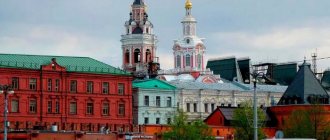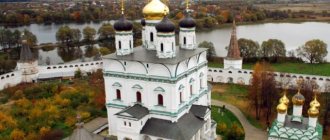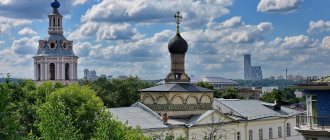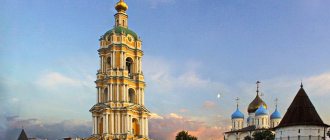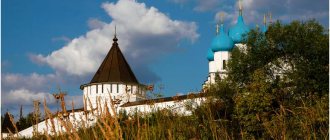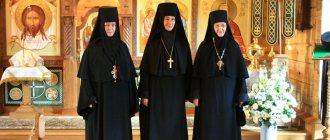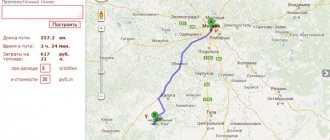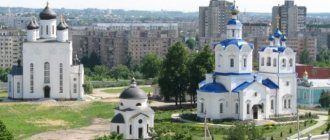Address: Teryaevo village, Volokolamsk district, Moscow region. Telephone,. How to get there: from Volokolamsk by bus to the village of Teryaevo; by train from Rizhsky station to Chismena station, then by bus 23, “Teryaevo stop”; along the Novo-Rizhskoye Highway (turn to Chismena) - 110 km from the Moscow Ring Road. Joseph-Volotsky Monastery was popular among the residents of Volokolamsk not only in the 21st century, but also in Soviet times. Even at a time when Orthodox believers were forced to hide their affiliation with Christianity, this monastery was not empty. If you believe the stories of numerous pilgrims, their prayers never went unheard.
Story
The monastery was founded in 1479 by St. Joseph in the name of the Dormition of the Mother of God. It belonged to the Novgorod diocese, then, after the hegumen’s quarrel with the Novgorod archbishop Serapion, to the Moscow diocese.
In 1543, Gury, later the first Kazan Archbishop, became the abbot of the monastery. During his time in the monastery, Saint Herman took monastic vows, becoming his disciple and successor at the Kazan department.
The main surviving buildings date back to the 16th–17th centuries.
The first stone cathedral was built in the 15th century. In its place there is now a cathedral church in the name of the Dormition of the Mother of God (1688-1696), built in the Moscow Baroque style.
Bell tower and Assumption Cathedral of the monastery. Photo approx. 1900
Other buildings include: the refectory chamber with the Church of the Epiphany (1504), the gate church of the Holy Apostles Peter and Paul (1679), the monastery with the Church of All Saints (1856-1860). Stepan Polubes, known for his work in the New Jerusalem and Solotchinsky monasteries, worked on the creation of tiled decorations.
The bell tower with the Church of the Smolensk Hodegetria located in its lower tier (1495), from which Moscow could be seen in clear weather, was blown up during the Great Patriotic War during the retreat of the Red Army troops.
Prince Boris Vasilyevich Volotsky gave funds for the construction of the monastery.
The monastery acquired particular fame in the 16th century. Kings and commoners began to come here to pray. The monastery was a place of imprisonment for enemies of the sovereign and heretics.
Many famous people in history were imprisoned in the monastery: the monk Vassian Kosoy (in the world Prince Vasily Ivanovich Patrikeev-Kosoy), Maxim the Greek, Tsar Vasily Ivanovich Shuisky, heretics Matvey Bashkin and Vasily Kuritsyn.
During the Russian-Polish War at the beginning of the 17th century, Polish prisoners of war were kept here, and French prisoners were kept here during the Patriotic War of 1812. From 1777 to 1823, there was a school for the children of priests in the monastery.
The relics of St. Joseph rest in the monastery; Princes John and Theodore Borisovich of Volotsk were also buried; Metropolitan Daniel, exiled here by Ivan the Terrible; Archbishop of Novgorod Theodosius; head of the guardsmen Malyuta Skuratov (Grigory Lukyanovich Skuratov-Belsky); landowner of the village of Yaropolets N.I. Goncharova (mother-in-law of A.S. Pushkin).
The monastery was famous for its large library containing books, manuscripts, grants, deeds and other documents from the 15th century. Ancient objects were kept in the sacristy.
1895 - rector Archimandrite Sergius.
1903 - rector Archimandrite Geronty, treasurer and housekeeper - hieromonk Irakli.
1907 - rector Archimandrite Nifont, treasurer - Hieromonk Irakli, acting housekeeper - Hierodeacon Meletius, dean of the monastery - Hieromonk Pavel. The number of brethren is 65 monks.
1908 - the same, but the treasurer was Hieromonk Paphnutius.
Before the 1917 revolution, the monastery was the site of fairs.
In 1922 the monastery was closed. Ancient manuscripts, documents and books of the monastery were mostly transported to Moscow and are currently in the RGADA, State Historical Museum, Russian State Library, as well as in St. Petersburg - in the archives of the St. Petersburg branch of the Institute of Russian History of the Russian Academy of Sciences.
Joseph-Volokolamsk Monastery
Until 1929, the monastery was geographically located in the Buigorod volost of the Volokolamsk district of the Moscow province. After 1929, the monastery was located on the territory of the Volokolamsk district of the Moscow region. Nowadays it is the territory of the rural settlement of Teryaevskoye as part of the Volokolamsk region.
After the closure of the monastery, an orphanage was located on its territory, and the Detgorodkovskaya secondary school was located in the fraternal building. The Assumption Cathedral was adapted into a cinema hall. The iconostasis with ancient icons was blocked by a movie screen.
At the beginning of the Great Patriotic War, the bulk of the orphanage residents were evacuated, many children died on the way.
In October 1941, the territory of the monastery was occupied by the Red Army, and after its retreat - by German troops. On December 18, 1941, the territory of the monastery was liberated from fascist occupation by soldiers of the 84th Separate Marine Rifle Brigade of the 1st Shock Army of the Western Front.
After the liberation of the territory from fascist occupation, the orphanage returned to the monastery. The monastery was restored, however, not completely. The unique bell tower has not yet been restored.
Important monastery shrines
Joseph-Volotsky Monastery is famous for its shrines, some of them are hundreds of years old. For example, a canvas depicting Jesus Christ, decorated with precious stones and given to the church by Princess Euphrosyne and her husband, Prince Staritsky, or crosses with relics located on the throne. Among the church images, the most revered are the icons of St. Joseph, the Chernigov Most Holy Theotokos and the Vladimir Icon of the Mother of God located in the main cathedral iconostasis.
Tomb at the monastery
Joseph Volotsky died in 1515. As a saint, he was immortalized only at the end of the 16th century. His remains are securely hidden in a secluded place in the Assumption Cathedral Church, covered with a special ark. The lower church of the cathedral contains tombs where bishops Nifont, Savva, Lavrentiy, Jeremiah, Theodosius, Metropolitan Daniel of Moscow and princes from Volokolamsk are buried. The well-known Malyuta Skuratov, who lived under Ivan III, also found his eternal refuge there. The cemetery at the monastery served as a burial vault for many nobles and princes: Bezobrazov, Shakhovsky, Golitsyn, Goncharov and Muravyov.
Architectural ensemble
The architectural ensemble of the Joseph-Volotsky Monastery is a classic example of the art of Ancient Rus'. In the second half of the 17th century, it was supplemented with elements of the Italian Baroque architectural style and became even more pompous and luxurious. Already in 1504, a chamber for meals and the Church of the Appearance of God were built in it. A few years after construction, thanks to the funding of Prince Boris Volotsky, innovations were introduced into the decoration. The construction of the Temple of Smolensk Hodegetria was carried out in the first tier of the bell tower. The transformations took a long time. Soon a new church was built in memory of the Venerable Apostles Paul and Peter. The monastic abbots lived in rooms located within the fence of the Orthodox monastery. A little further there were fraternal buildings where the monks spent their time, a department for the treasury and buildings for household needs. All this together made up the Joseph-Volotsky Monastery. The monks who lived in the monastery had to take care of strengthening the home they had chosen for themselves. The fortress walls were built in the 16th century. However, they had to be rebuilt in 1650. About 100 years later, high towers were erected around this Orthodox shrine. During the construction of the monastery, the monks did not forget about the Orthodox Christians who would like to visit here. In 1865, the construction of a hotel establishment where pilgrims could while away their time was completed. Not far from it there is a building for the poor and disabled, as well as a hospital.
Joseph-Volotsky Monastery is an extremely interesting place for tourists. It impresses with its rich history and sophistication of the architectural ensemble. Like any Orthodox shrine, it charges you with energy and allows you to take a little break from the bustle of everyday life.
Revival. Modern life
Returned to the Russian Orthodox Church on May 15, 1989; since 1999 it has the status of stauropegial. Until November 2003, the abbot of the monastery was Metropolitan Pitirim (Nechaev).
On June 12, 2003, the relics of St. Joseph of Volotsk were discovered in the Joseph-Volotsky Monastery and placed in a shrine in the lower church of the Assumption Cathedral. The burial was opened by archaeologists Yu. A. Smirnov, M. V. Frolov and P. E. Rusakov at a depth of 225 cm - where, according to legend, the Monk Joseph of Volotsky was buried. A detailed medical and forensic study of the relics, with the blessing of Metropolitan Pitirim of Volokolamsk and Yuryev, was carried out by: Honored Doctor of the Russian Federation, Doctor of Medical Sciences, Professor V. N. Zvyagin; forensic experts M. E. Berezovsky, N. V. Narina, S. A. Aunapu; anthropologist M. A. Grigorieva and other researchers.
On June 12, 2004, the chains of St. Joseph of Volotsky were transferred to the Joseph-Volotsky Monastery, which had previously been kept first in the New Jerusalem historical, architectural and art museum in Istra, and then in the Volokolamsk Kremlin museum and exhibition complex. Currently, the chains are located in the Assumption Cathedral of the monastery, near the southern wall and are available for worship.
On June 14, 2004, the monastery, which celebrated the 525th anniversary of its foundation, was visited by Patriarch Alexy II and celebrated the Divine Liturgy in the Assumption Cathedral.
On June 14, 2009, a monument to St. Joseph was unveiled near the monastery (on the south side) - a full-length bronze sculpture, three meters high, on a two-meter stone pedestal. Sculptor - Sergey Isakov.
On October 13, 2009, Patriarch Kirill visited the monastery and celebrated the Divine Liturgy in the Assumption Cathedral.
Currently [when?] the abbot of the monastery is Archimandrite Sergius (Voronkov).
There is a hotel at the monastery for 120 people.
On July 16, 2015, a meeting of the Board of Trustees, headed by Patriarch Kirill, was held, at which the Governor of the Moscow Region A. Yu. Vorobyov was elected its Chairman.
2015 is the year of the 500th anniversary of the repose of the founder of the monastery - St. St. Joseph Volotsky.
Schedule
The current schedule of services in the Joseph-Volotsky Monastery for the coming week is posted on the official website of the monastery. On ordinary days, morning services begin at 6.30 - 7:30 o'clock, and evening services at 17:00 o'clock. On holidays the schedule is different.
Schedule of services at the Joseph-Volotsky Monastery
Monument to St. Joseph and Gate Church, © Sonic_off
History of the Joseph-Volotsky Monastery
John Sanin (the name of St. Joseph in the world) was born in 1439 in the family village of Yazvische. Even at a young age he began to learn to read the Psalter, and at 8 he was already reading all the divine books and became a reader and singer in the temple. At the age of 20, the monk decided to devote his life to serving God and went to the Savvin Monastery in Tver. From there he was sent to the Monk Paphnutius of Borovsky, who was his mentor and teacher.
The best article for you, go to: St. George's Monastery Veliky Novgorod
It should be noted that at that time there were no universities in Rus' and people studied and educated themselves by reading and copying books. For his time, Joseph was very smart and educated. His erudition was amazing. In 1477, St. Paphnutius died, but before his death he bequeathed to appoint Joseph as his successor. But despite this, the abbot began to have disagreements with other ministers of the community.
The whole point is that he wanted to make it a community center, but the brethren were against such a decision. Then he decided that before changing the charter, he needed to get acquainted with the life of other similar monasteries. Taking the old man as his traveling companion, he set off to wander.
Over the course of a year, under the guise of a novice, he visited several monasteries, but most of all he liked Kirillo-Belozersky. St. Kirill Belozersky was an ardent supporter of the hostel, and its charter was considered the strictest. Returning back, John again began to change the charter, but after another unsuccessful attempt, he began to create his own monastery, taking the Kirillov Monastery as an example.
The best article for you, go to: Optina Pustyn Monastery: where it is, how to get there, history
From the very beginning, a strict dormitory was laid down in it. It was built under a cross, which was placed from the very beginning with the image of the Virgin Mary. The basis of all the monk’s relationships with people was almsgiving and love of goodness. He always organized assistance to impoverished peasants. An orphanage was set up at the St. Joseph of Volotsk Monastery, where about fifty children gathered during the famine in 1515. Every day the monastery fed about 400 hungry people.
The Saints
The history of this monastery is connected with the lives of several righteous people, among them St. Herman, who was engaged in rewriting and interpreting church books. For several years he was Archbishop of Kazan. In the library of the monastery, many years after Herman’s death, books copied by his hand were preserved as shrines. While being a monk of the Joseph-Volotsk Monastery, he met Maxim the Greek.
This translator and interpreter of Christian literature came to Russia from Athos at the request of Grand Duke Vasily the Third. Among other things, he was involved in the translation of the Explanatory Psalter. But after some time, the monk was exiled to the Volokolamsk Monastery for criticizing part of the Russian clergy. He actively opposed the fact that some monasteries had wealth, lands and a large number of serfs.
History of the monastery
Figure 1. Joseph Volotsky
The creator of the monastery was Joseph Volotsky. This man is glorified by the church in the ranks of the venerable saints. He lived in the 16th century and came from a noble family with Lithuanian roots. Joseph was the first person in his family to take monastic vows. Subsequently, several more men from this family followed his example.
For a long time he lived in the Savvina monastery and was even its abbot. However, the strict ascetic way of life that Joseph started did not please the rest of the brethren. And the monk left the monastery in order to found his own Volokolamsk monastery. It is also called Joseph-Volotsky.
A strict way of life was established in this monastery from the very beginning. The Monk Joseph accepted into it all the monks who wanted to settle here. The saint gave most of the monastery's budget to the needy.
Interesting! The construction of the monastery progressed at a rapid pace. The first wooden temple was erected here in just two months. In less than seven years, a stone church was built. The icons for this cathedral, as well as the frescoes, were painted by the outstanding icon painter Dionysius, a student of Andrei Rublev.
Subsequently, a high bell tower in the shape of an octagonal tower was built near the temple. The Ivan the Great Bell Tower in Moscow was built according to its model. At the base of this tower was the Church of the Icon of the Smolensk Mother of God.
Monastery today
Figure 2. Fortress wall
The monastery in question has on its territory several churches and other buildings built in the 15th and 16th centuries.
The outer walls of many churches are decorated with tiles by the artist Stepan Polubes. He is mainly known as the master who worked on the decoration of the New Jerusalem Monastery.
Pilgrimage and excursions
Tourists and pilgrims coming to the Joseph-Volotsky Monastery are met and accompanied by the Pilgrimage Center. Guests are offered a one and a half hour guided tour of the monastery. Visitors are introduced to the architecture of the monastery, they visit the Assumption Cathedral, the Refectory Chamber, climb the fortress wall and the German Tower. During the excursion conversation, topics of construction, centuries-old history and revival of the monastery are touched upon, stories are told that connect the monastery with the names of many Russian autocrats. The excursions are conducted by the monastery brothers and obedient students of St. Tikhon's Humanitarian University.
Bible Museum
The first Bible museum in Russia was created in the Joseph-Volotsky Monastery. The basis of the collection is the extensive library of Metropolitan Pitirim of Volokolamsk and Yuryev, the abbot of the monastery revived in 1989. In three halls of the museum, rare and unique editions of the Bible are presented: the Ostrog Bible of 1581, the Elizabethan Bible of the 2nd century, sacred books with illustrations by Durer, drawings by Salvador Dali. The collection of early printed and handwritten books is of particular value. In past centuries, one of the main obediences of the Joseph-Volotsk brotherhood was the rewriting of books. It is believed that by the middle of the 2nd century. the monastery had the largest manuscript library.
Museum of the Bible, © Elena Younes
For pilgrims
For the convenience of pilgrims, the Joseph-Volotsky Monastery offers accommodation in a hotel at the monastery. It offers rooms of varying degrees of comfort and cost. There is free Wi-Fi, a changing table and cot for babies, kitchen equipment and all the necessary amenities. Accommodation for pilgrims must be agreed in advance by phone +7 925 112 9011 or email [email protected]
In addition to the church shop operating at the cathedral, at the entrance to the monastery there is a large church store, where you can buy icons, books, candles and monastery souvenirs every day from 10:00 to 17:00. In the monastery you can rent bicycles, and in winter - cheesecakes for riding down the mountains.
Paintings on the walls of the Assumption Cathedral on Google maps panorama
How to get there
Address of the monastery: Moscow region, Volokolamsk district, village Teryaevo. To get to the shrine from Moscow, you first need to get to Volokolamsk by bus from the Tushinskaya metro station or by train to Chismena station. And then transfer to the bus to the village of Teryaevo.
By car from Moscow you need to drive along the Novorizhskoe highway for about 98 km, then turn right to Chismena station, and after the railway crossing continue to the village of Teryaevo, pass the village and go around the pond. Starting from the turn onto Novorizhskoye Highway there will be signs to the monastery.
May the Lord protect you!
You will also be interested in watching a video about the holy monastery:
